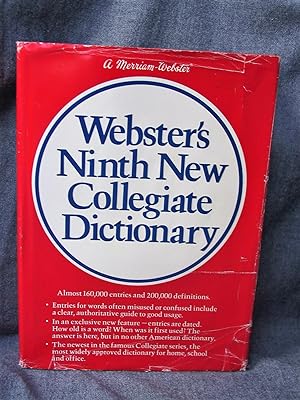noah webster john bethel (2 Ergebnisse)
Produktart
- Alle Product Types
- Bücher (2)
- Magazine & Zeitschriften
- Comics
- Noten
- Kunst, Grafik & Poster
- Fotografien
- Karten
- Manuskripte & Papierantiquitäten
Zustand
- Alle
- Neu
- Antiquarisch (2)
Einband
- alle Einbände
- Hardcover (2)
- Softcover
Weitere Eigenschaften
- Erstausgabe
- Signiert
- Schutzumschlag (1)
- Angebotsfoto (1)
- Keine Print-on-Demand Angebote (2)
Gratisversand
- Versand nach USA gratis
Land des Verkäufers
Verkäuferbewertung
-
Websters New Collegiate Dictionary
Verlag: Thomas Allen & Son Ltd, 1989
ISBN 10: 0919028667ISBN 13: 9780919028661
Anbieter: ThriftBooks-Atlanta, AUSTELL, GA, USA
Buch
Hardcover. Zustand: Good. No Jacket. Missing dust jacket; Pages can have notes/highlighting. Spine may show signs of wear. ~ ThriftBooks: Read More, Spend Less 3.5.
-
Webster's Ninth New Collegiate Dictionary
Verlag: A Merriam-Webster Thomas Allen & Son Limited (Registered User of the Trademarks of Merriam-Webster Inc.), Markham, 1989
ISBN 10: 0919028667ISBN 13: 9780919028661
Anbieter: Past Pages, Oshawa, ON, Kanada
Buch
Hard Cover. Zustand: Good. Zustand des Schutzumschlags: Good. BOOK: Previous Owner Markings (Designated Inscription Spaces on Front Free Endpaper Neatly Completed in Ink); Corners, Spine, Boards Bumped; Light Shelf Rub to Boards; Edges, Endpapers Moderately Soiled. DUST JACKET: Previous Owner Markings (Price Clipped); Repaired; Moderately Creased; Moderately Chipped; Slight Yellowing Due to Age; In Archival Quality Jacket Cover. EDITION: Hardcover With Dust Jacket. Indexed Edition (Inlaid Finger Tabs). Indexed. Merriam-Webster. More people take our word for it. Webster's Ninth New Collegiate Dictionary does not begin with A or end with Z. It provides a wealth of useful information not found in other dictionaries. Almost 160,000 entries and 200,000 definitions. Entries for words often misused or confused include a clear, authoritative guide to good usage. In an exclusive new feature--entries are dated. How old is a word? When was it first used? The answer is here, but in no other American dictionary. The newest in the famous Collegiate series, the most widely approved dictionary for home, school and office. CONTENTS: Preface; Explanatory Chart; Explanatory Notes; The English Language in the Dictionary; Guide to Pronunciation; English Spelling and Sound Correspondences; Abbreviations in This Work; Pronunciation Symbols; Dictionary of the English Language; Abbreviations and Symbols for Chemical Elements; Foreign Words and Phrases; Biographical Names; Geographical Names; Colleges and Universities; Signs and Symbols; A Handbook of Style; Index. SYNOPSIS: More than 11,000,000 hardcover copies of the Eighth Edition of Webster's New Collegiate Dictionary were sold in the ten years it was in print. Now with the ninth Edition, Merriam-Webster brings you the very latest in this best-selling tradition. And with it come two important new features. DATING: How old is earthling? (almost 400 years) When did brat first enter the language? (1925) This kind of question is often asked, and now, uniquely in Webster's Ninth New Collegiate Dictionary you will find the answers. Answers available in no other American dictionary. For the first time, the dictionary is not only functional; it invites browsing. The knowledge that finalize was being used in 1922 may have a bearing on your view of its acceptability today. That knowledge may also stimulate your interest in when other -ize words, such as energize, entered the language. (1752) This unique feature is made possible through the incomparable Merriam-Webster archives. This resource, undoubtedly the worlds' largest, now includes over 13,000,000 citations of words in action, together with the surrounding text. Original evidence of actual usage available only to Merriam-Webster editors. It is important to note that in all Merriam-Webster dictionaries, senses of multisense words are shown in historical order; thus, the first entered sense is the oldest entered sense. Since the user would only be misled by a date unconnected to a meaning, it is the first entered sense that is dated. An unentered sense, even if older, is ignored. The word nice, for example, came into the language about 700 years ago meaning "silly." That sense has not been in use for over 400 years, and to show a date for a sense that does not itself qualify for entry in the book would be, at the very least, unhelpful. The editors are, of course, always trying to uncover evidence of an earlier usage, and if any of our readers can provide us with written evidence to that effect we will be appreciative. (No reward, just our thanks.) Both the scholar and the curious layman will find this exclusive feature of the Ninth Edition a valuable and unusually interesting new dimension to the dictionary. USAGE: The second major departure from past practice relates to a matter of great concern to many people--good usage. Until now, dictionary editors have generally been content to limit their involvement in this area to usage labels (obs., lit.), brief usage notes (usually taken to be offensive), or ambiguous op.



